After his contentious penalty for slowing sharply in front of George Russell in the Australian Grand Prix, Fernando Alonso predicted the case will be a one-off, of a tyre he has seen before in his career.
“It will never be repeated the same,” he said. “I think we will never see a decision like in Australia ever again. So I accept it, I take it.
“I had a few of those, many, too many of those in my career.”
As F1’s most experienced driver by far, and one of its toughest competitors, it’s no surprise Alonso has been pulled up before the stewards many times in his career. And he is right when he points out he’s been involved in and penalised for some rare, unusual and even unique cases.
2005 Japanese Grand Prix
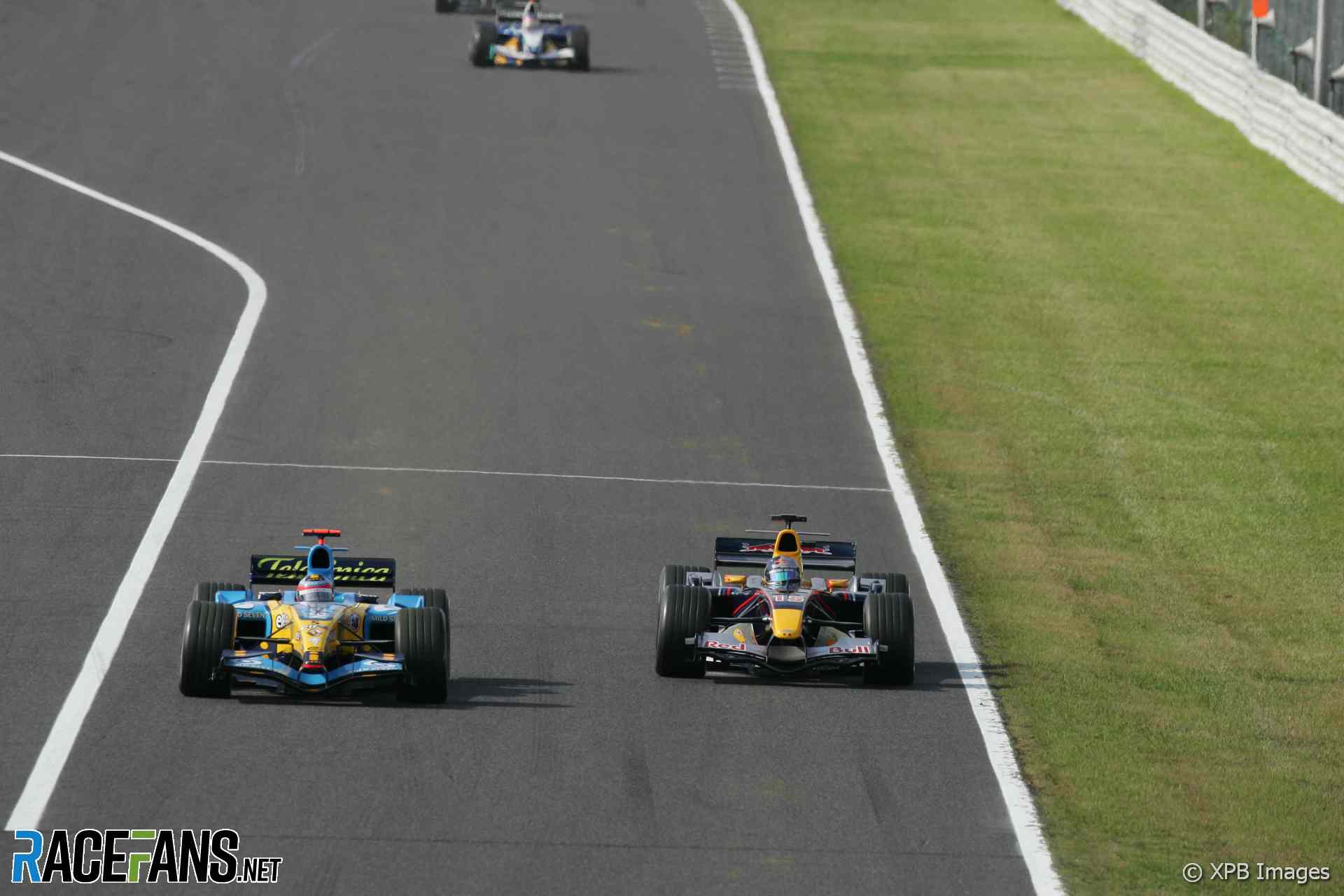
Penalty: Allow Klien to re-pass him
Consequence: Lost around eight seconds
Climbing through the field, after a rain-affected qualifying session left him 16th on the grid, Alonso ran off-track at the chicane while overtaking Christian Klien. He let the Red Bull driver through on the following straight, then immediately re-passed him, but the stewards considered this insufficient.
Alonso was instructed to let Klien by again, and although he eventually passed Klien again, his pursuing rival Kimi Raikkonen had gained around eight seconds on him. That ultimately helped the McLaren driver jump ahead of Alonso through the pit stops on his way to a celebrated victory.
Rubbing salt into the wounds, before the race was over the stewards admitted they had been wrong to tell Alonso to let Klien through again. A driver being penalised for cutting a corner to pass a rival is hardly a “one-off” matter, but the stewards’ indecisiveness on this occasion made their handling of the case highly unusual, and cost Alonso a shot at victory.
2006 Hungarian Grand Prix

Penalty: One second added to his qualifying times (plus the same for another incident)
Consequence: Failed to make the cut for Q3 and therefore started 15th
In the thick of his title fight with Michael Schumacher, Alonso was hauled before the stewards at the Hungaroring after he lost his cool with Robert Doornbos during practice and brake-tested the Red Bull driver. He was given the unusual penalty of one second added to all his qualifying lap times, a sanction which was doubled when the stewards discovered he also overtook a rival under yellow flags.
Three years earlier at the Nurburgring, Alonso went unpenalised after another rival accused him of brake-testing. On that occasion David Coulthard claimed Alonso had braked 10 metres earlier than usual for the chicane, leading him to lose control, in circumstances reminiscent of this year’s incident at Melbourne.
Alonso’s penalty in Hungary left him well down on the grid, but a sublime opening lap on a damp track soon brought him back into contention. A botched Renault pit stop ended his race early, however.
The unusual detail in this incident was the nature of Alonso’s penalty. The stewards soon moved from time penalties to grid drops for qualifying incidents, though Schumacher also collected two seconds of grid penalties at the same event.
Advert | Become a RaceFans supporter and
2006 Italian Grand Prix

Penalty: Five-place grid drop
Consequence: Moved Alonso from 5th to 10th on the grid
If Alonso was displeased by his treatment in Hungary, he was incandescent a month later at Monza. After suffering a puncture during qualifying, he produced a gem of a lap to claim fifth on the grid. But he did so with Schumacher’s team mate Felipe Massa in his mirrors, and Ferrari were quick to claim he had been disadvantaged by Alonso’s slipstream.
The stewards agreed and handed Alonso a penalty. “I don’t consider F1 any more a sport,” fumed Alonso, his mood not helped by an engine failure ending his race, while Schumacher won and cut his points deficit to just two.
Penalties for impeding were not unheard of at the time, but this was by far one of the most contentious, and under today’s rules it probably wouldn’t attract a sanction.
2007 Hungarian Grand Prix
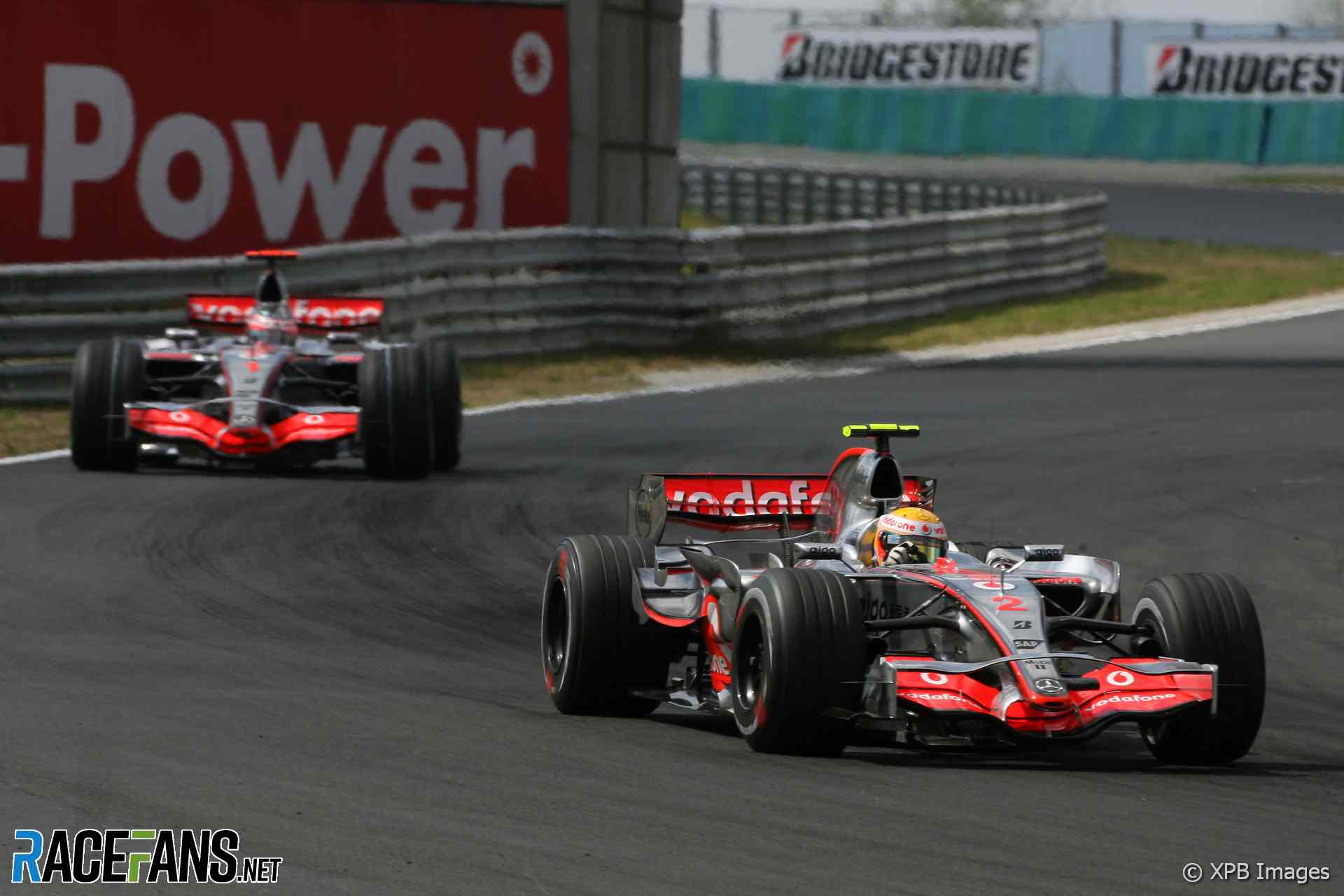
Penalty: Five-place grid drop
Consequence: Moved Alonso from 1st to 6th on the grid
Back in Hungary the following year, Alonso was now at McLaren and his title rival was team mate Lewis Hamilton. Relations between the pair and within the team were already strained, and at the Hungaroring they boiled over.
The trigger was Hamilton’s apparent refusal to follow a team instruction to let Alonso run in front of him as a final phase of qualifying began. Alonso retaliated by block Hamilton in the McLaren pit before they began their final runs, ensuring his team mate didn’t have enough time to begin his final run. The stewards concluded this was another example of impeding and penalised him.
Again, grid drops for impeding have become de rigueur. But this case was a ‘one off’ for two reasons. No other driver has ever intentionally blocked their own team mate in the pits this way. Plus, McLaren was ruled to have contributed to Hamilton’s delay by holding Alonso in the pits, and were told they would forfeit all their constructors’ championship points from that round.
That ultimately proved moot. The still-fuming Alonso told team principal Ron Dennis he had further details of the ‘spygate’ row McLaren was embroiled in with the FIA, setting in motion a series of events which ultimately led to the team’s disqualification from the constructors’ championship and record $100 million fine.
Advert | Become a RaceFans supporter and
2010 British Grand Prix

Penalty: Drive-through penalty during race
Consequence: Fell from 12th to 16th
In circumstances similar to those in Suzuka five years earlier, Alonso left the track while overtaking Robert Kubica. He failed to give the position back and his rival retired two laps later.
The stewards gave him the most lenient penalty available, which at the time was a drive-through. Making matters worse, it coincided with a Safety Car period. That left Alonso, fourth at one stage, 14th at the flag.
Though it would be a stretch to call this a “one-off” penalty, and he had no one but himself to blame for it, circumstances conspired to amplified the impact of his sanction. It was an error with potentially huge consequences in a season where he lost the title by just four points.
Alonso seldom found himself in contention for strong results during his mid-2010s spell in the often unreliable and slow McLaren-Honda. After two seasons out he returned with Alpine, and in the middle of his first year back said he “felt a little bit like an idiot” as he believed others were pushing the limits of the rules harder than he was.
“The strategy in the first races didn’t have any solutions or didn’t [bring] us any solution. So we understood that the solution is to do what the others are doing. That’s the only thing we can do.”
Advert | Become a RaceFans supporter and
2022 Miami Grand Prix
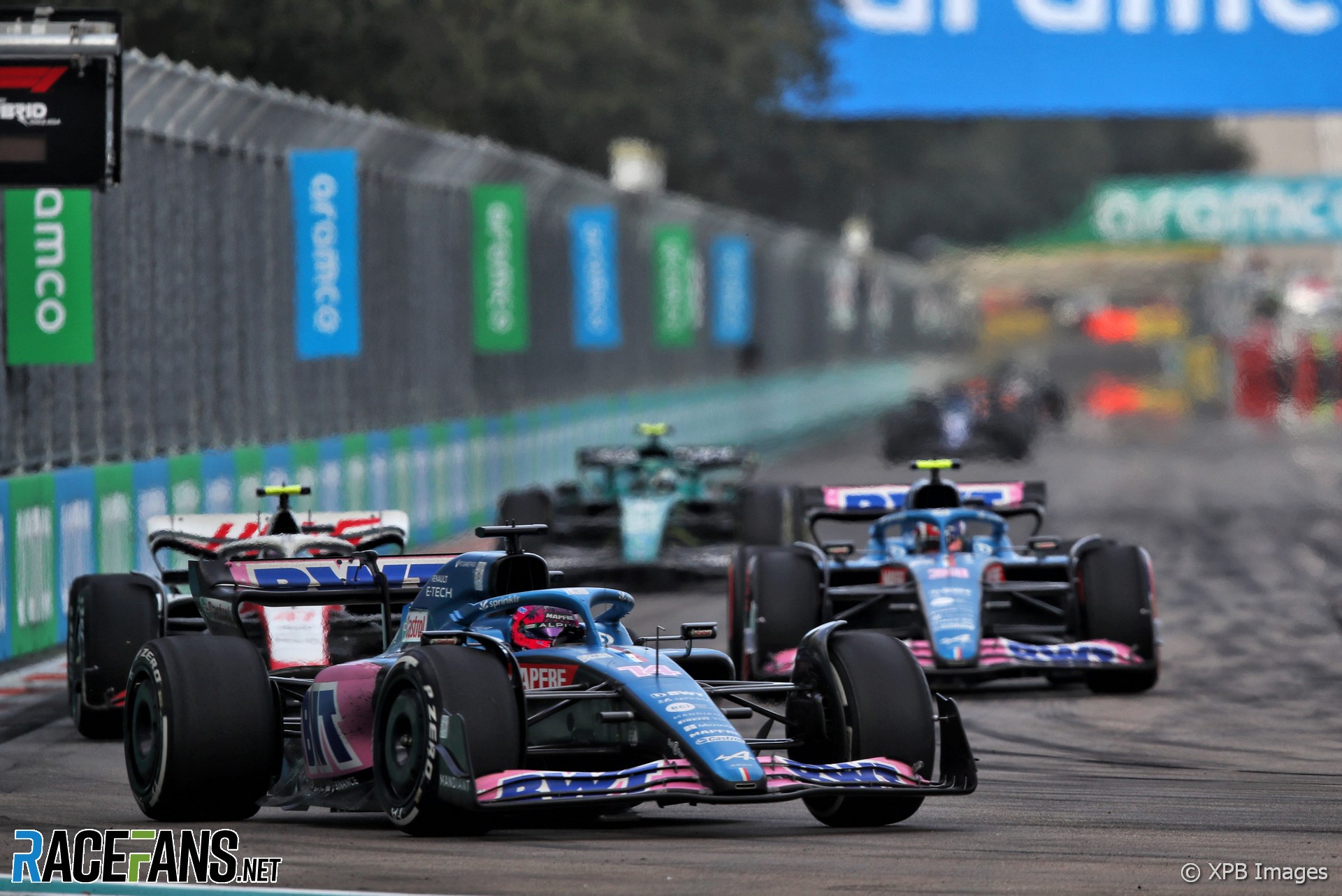
Penalty: Five-second time penalty post-race, one penalty point on his licence
Consequence: Fell from 9th to 11th
Alonso accused the Miami Grand Prix stewards of “incompetence” over a post-race five-second penalty which dropped him out of the points places in F1’s first race at the Miami International Autodrome in 2022. “They were not very professional, I think.”
The cause of his frustration was the second penalty the Alpine driver received that day, for cutting the chicane while running ahead of Mick Schumacher and Esteban Ocon in the second Alpine. It allowed Alonso to pull far enough ahead of Schumacher that the Haas driver no longer gained DRS from Alonso, allowing Ocon to attack him successfully.
Alonso told his team on the radio “I missed turn 14 but I lifted off next straight.” He went off at the same corner again three laps later, telling his team: “The brakes are locking.” The stewards did not take this in mitigation, and although the penalty he received was not unusual, the circumstances around it were.
2022 Canadian Grand Prix
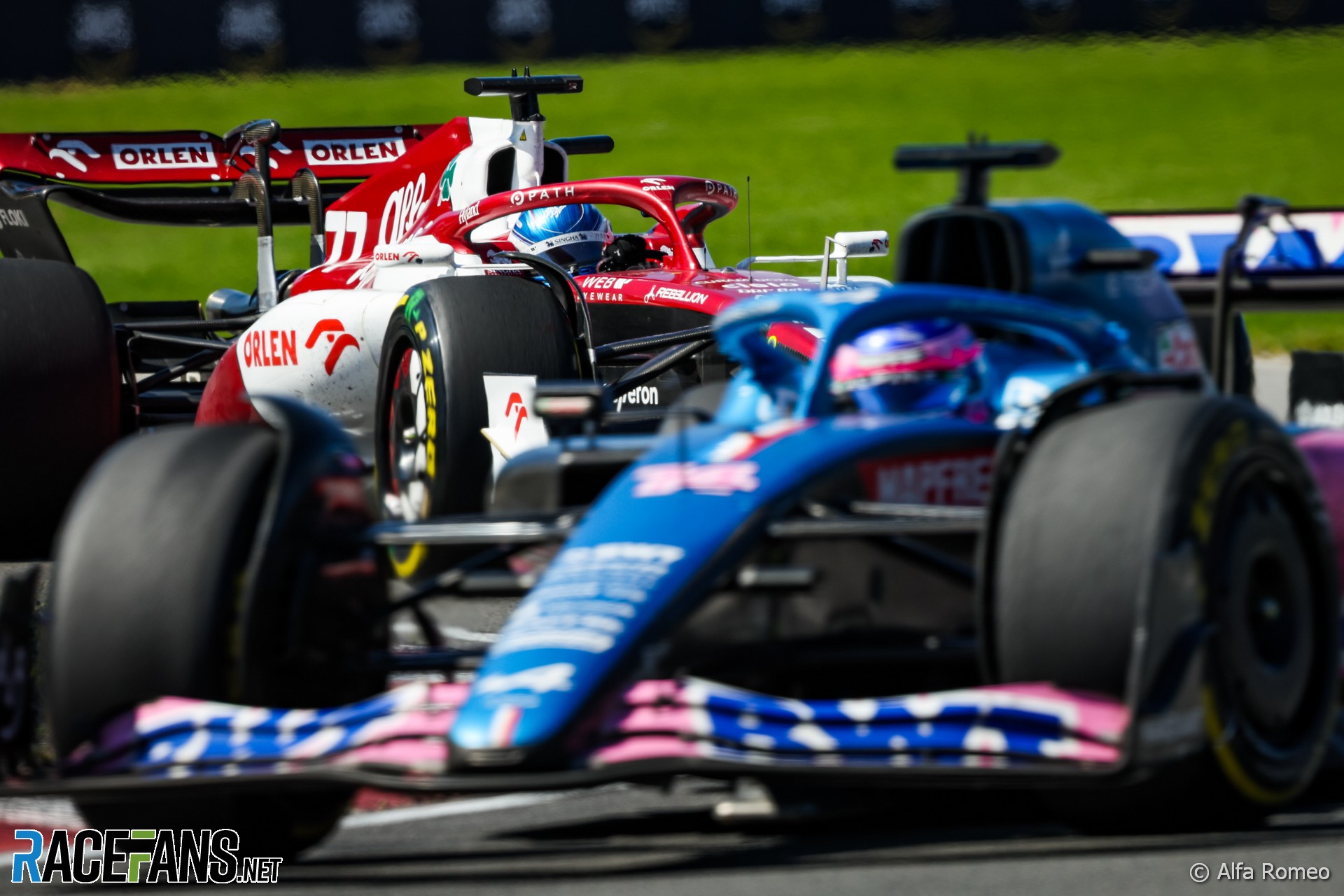
Penalty: Five-second time penalty post-race, one penalty point on his licence
Consequence: Alonso fell from 7th to 9th
In similar circumstances to the Australian Grand Prix this year, Alonso had a rival breathing down his neck over the final laps of the race. He did everything he could to keep Valtteri Bottas behind, but the Alfa Romeo driver accused him of “dangerous” weaving on the straight. The stewards agreed Alonso had gone too far and gave him a five-second time penalty.
However other drivers had committed similar moves the same year. The stewards even noted Lance Stroll had also changed lines too many times while under pressure from the same Alfa Romeo in the Melbourne round that year.
Advert | Become a RaceFans supporter and
2022 United States Grand Prix
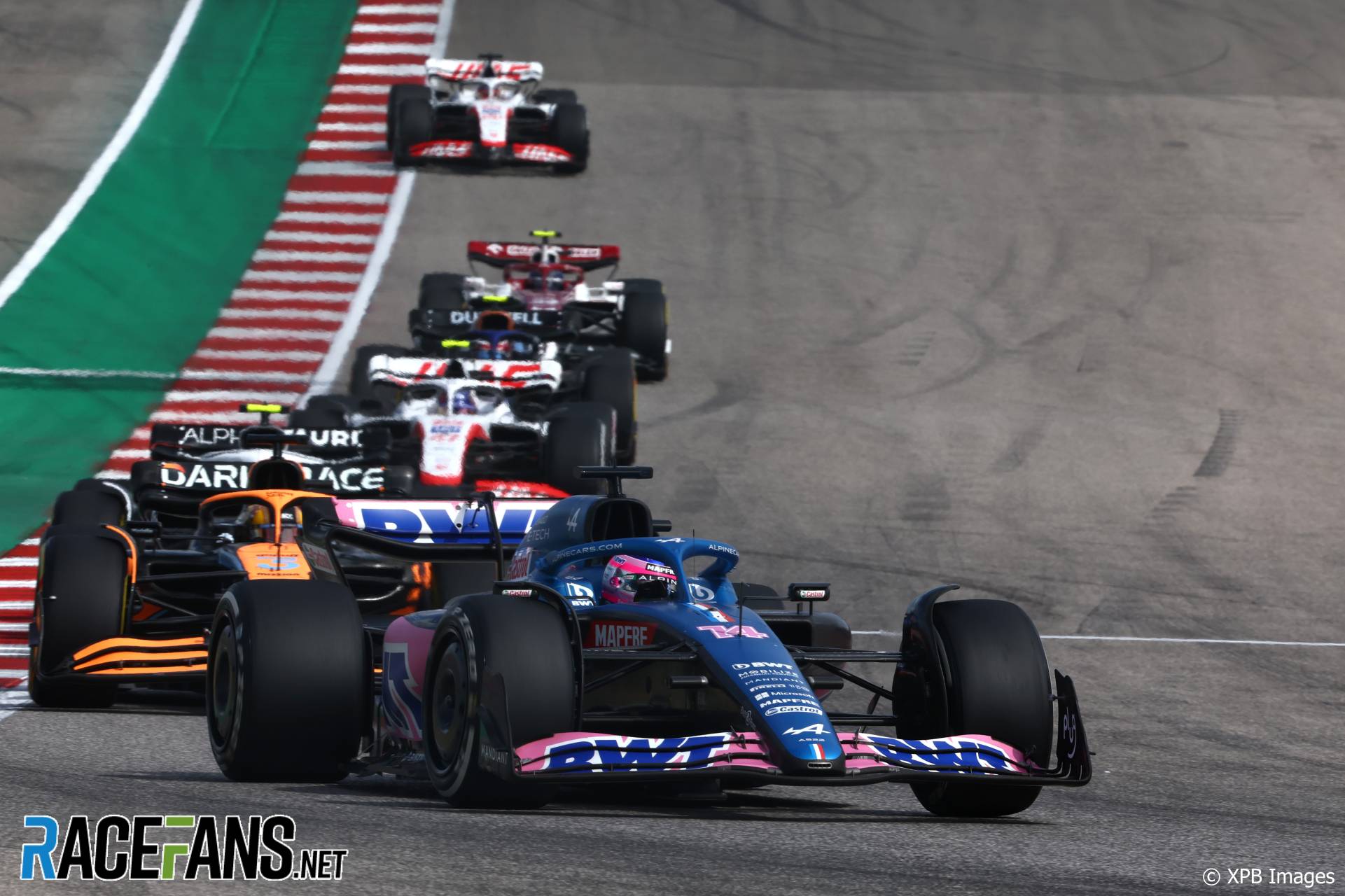
Penalty: 10-second stop-and-go penalty post-race, later overturned
Consequence: None (originally dropped Alonso from 7th to 15th)
Alonso could certainly claim to have incurred an unusual penalty at the Circuit of the Americas in 2022, but his team successfully overturned it on a technicality. He was originally given a severe post-race sanction equivalent to a 10-second stop-and-go penalty (adding 30 seconds to his time), which dropped him well out of the points places.
This was not for a driving error, but because his team allowed him to continue driving with a loose wing mirror. The stewards said they were “deeply concerned” Alonso was not shown the black-and-orange flag.
Rivals Haas weren’t impressed either, and their petition to the stewards led to Alonso being penalised. It was cancelled when Alpine pointed out Haas submitted their paperwork too late. Without that, it would have been another unusual penalty call involving the two-times champion.
2023 Saudi Arabian Grand Prix
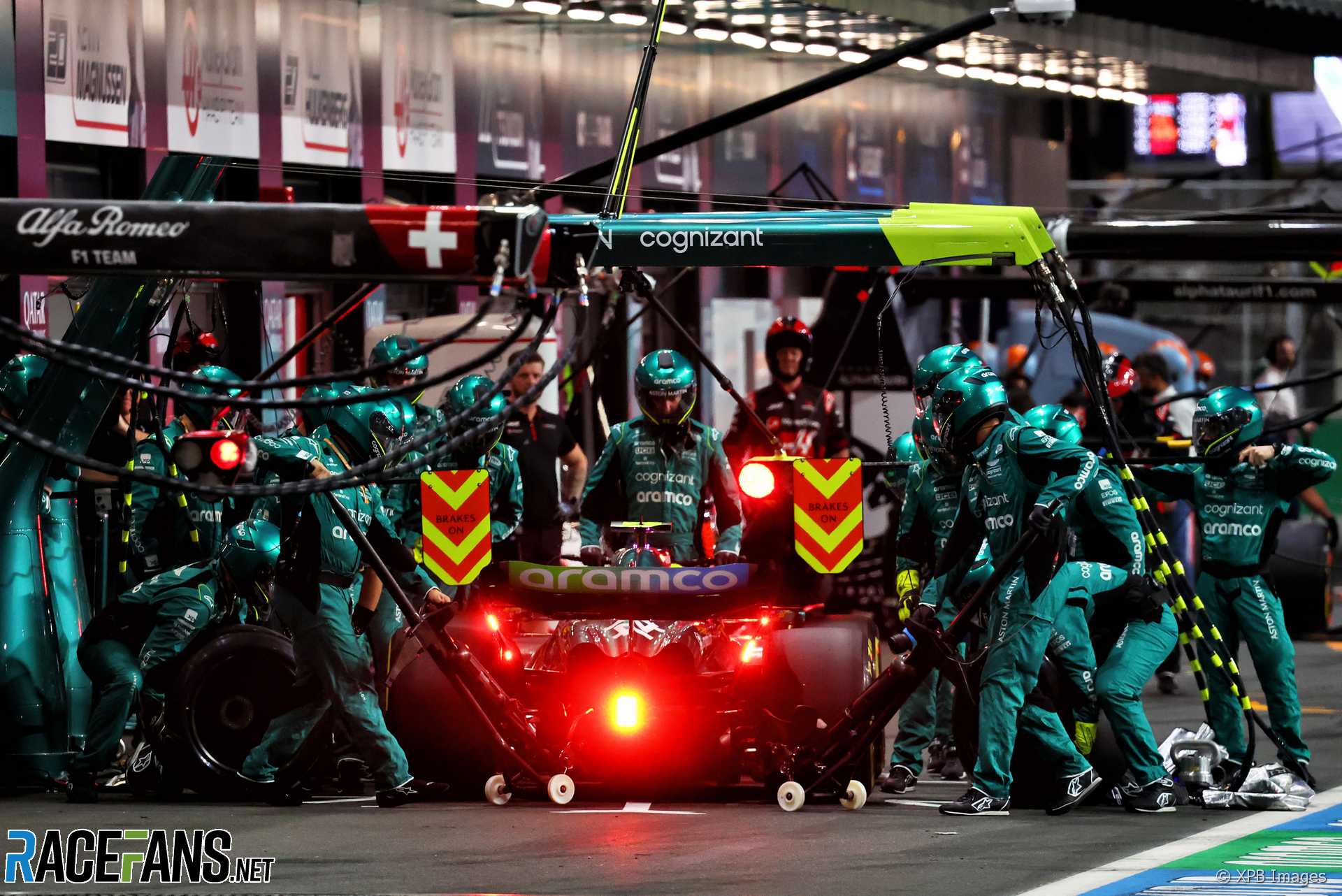
Penalty: 10-second penalty post-race, later overturned
Consequence: None (originally dropped Alonso from 3rd to 4th)
Another case of a penalty which was issued for a reason other than Alonso’s driving, which was later overturned. The stewards initially ruled Aston Martin touched Alonso’s car while he was serving a five-second time penalty and handed him an additional 10-second penalty which dropped him out of the podium places.
Aston Martin requested a review of the decision and the stewards accepted their argument that there had been many past cased where a car had been touched with a jack while a penalty was being served. The regulation were later updated, and Alonso got his podium finish back.
This case had a strange coda, however: Earlier this year no less than FIA president Mohamed Ben Sulayem was accused of having attempted to influence the stewards. He was investigated by the FIA’s Ethics Committee, who cleared him.
Advert | Become a RaceFans supporter and
2024 Australian Grand Prix
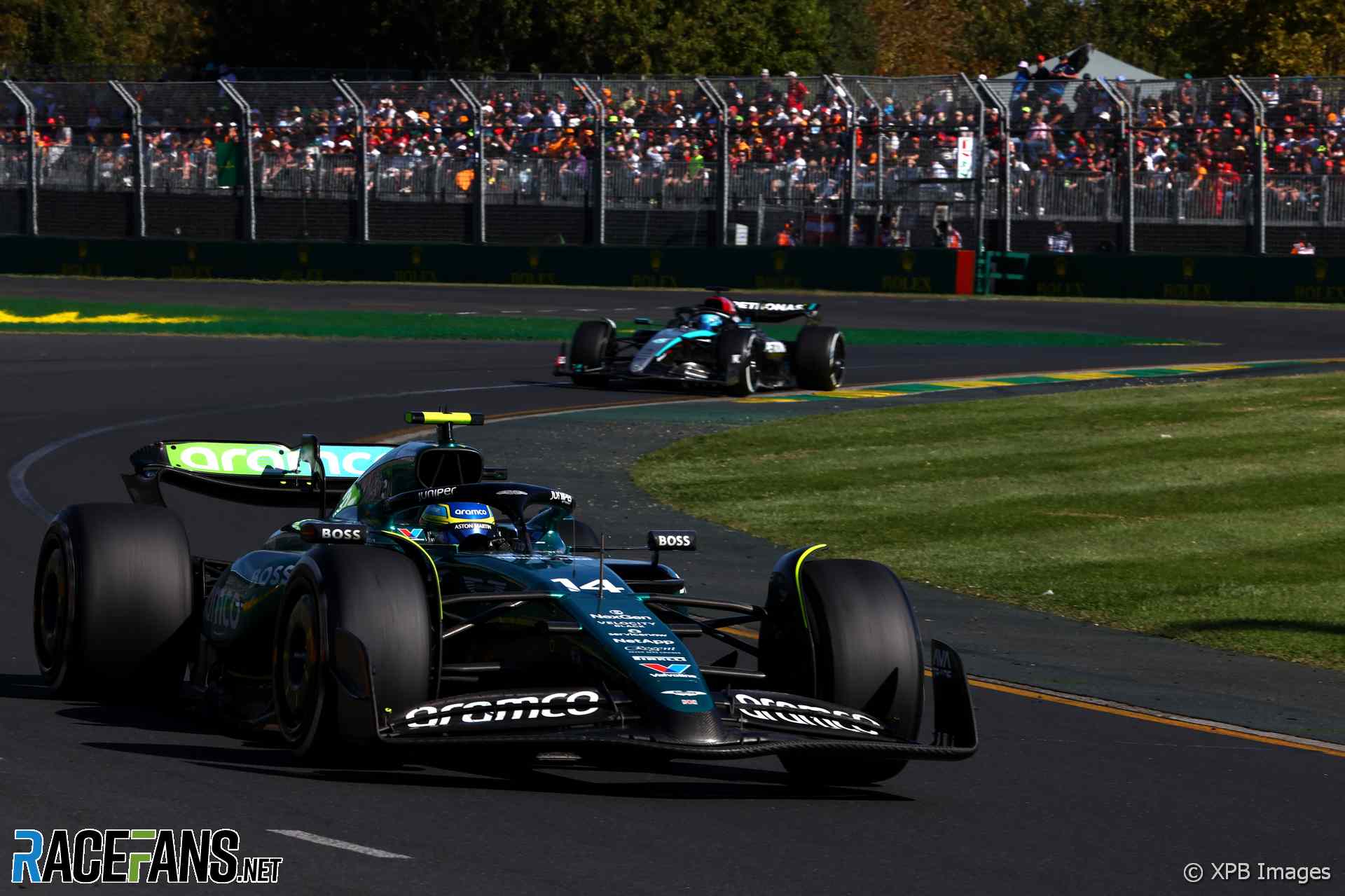
Consequence: Alonso fell from 6th to 8th
Alonso predicted his most recent penalty “will never be repeated the same” in future. It’s certainly true that other penalties earlier in his career have been one-offs and this may prove to be the same.
However, while some of the most memorable penalties Alonso received were influenced by unfortunate timing (Monza 2006, Silverstone 2010), others were products of his efforts to exploit the grey areas in the rules to his advantage. All drivers do this, but some do it more persistently and more successfully than others. Alonso is often one of them.
But with that comes the possibility that the stewards may decide from time to time he has pushed the rules too far. The Melbourne case this year was probably one of the clearest examples of this so far. It certainly proved divisive among RaceFans readers, who at the time of writing are split down the middle over whether his strong penalty was deserved, or excessive.
- Poll: Were stewards right to penalise Alonso over his driving before Russell’s crash?
- What were Alonso’s battery and throttle problems in the final stint of his race?
F1 history
- How you rated F1’s 12 sprint races so far – and why two outscored the grand prix
- Alonso set to become F1’s oldest driver for more than 50 years
- From ‘Flying Pig’ to Senna’s heroics: The short, incredible history of Toleman
- From farcical to fantastic: Formula 1’s 14 title-deciding Japanese races ranked
- Benched: The five other drivers who stood down for team mates in last 50 years




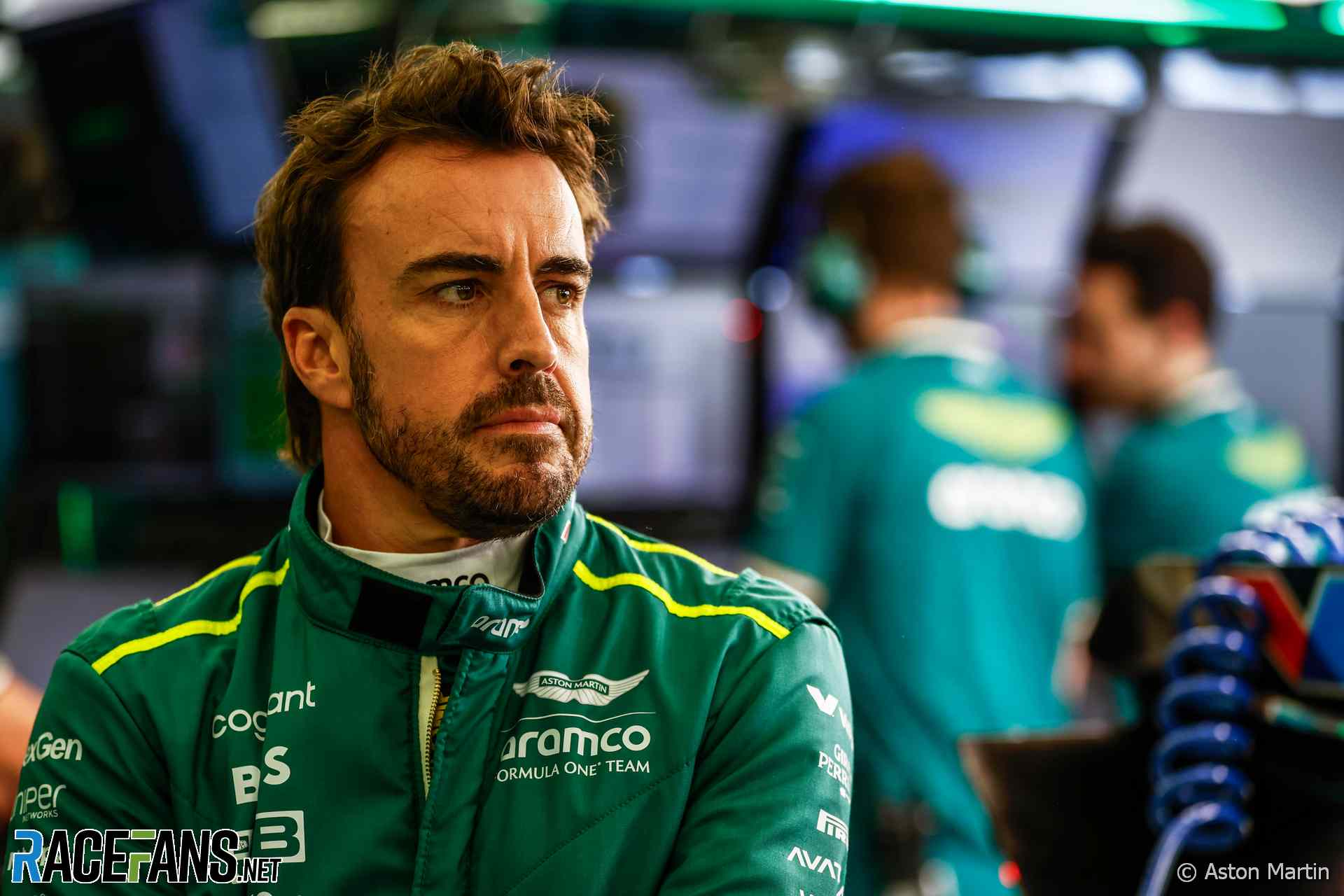
BasCB (@bascb)
17th April 2024, 7:46
Interesting. I do think that some of these were contentious, but then, let’s also not forget that Alonso himself also has done some pretty unprecedented things in the sport as well as looking for every last way to fight on track at times meaning he gets close to the gray zone with some of those which then lead to penalties, but also to changes in what is deemed acceptable (or not) and to changes of how drivers act on track or even rule changes/clarifications.
Retired (@jeff1s)
17th April 2024, 18:12
What goes around comes around.
Nick T.
17th April 2024, 20:45
What a surprise from you. Please tell us what was going around?
The Silverstone one was one of the worst I’ve ever seen. And the Hungarian 2007 penalty was ridiculous in the full context of what happened. Three places would have been fair perhaps. Not 9 or whatever it was. While not a penalty, 2010 Valencia was ridiculous as well.
Most of this basically comes back to 2007. The British media basically turned Alonso into the most hilariously cartoonish villain. As Brundle said at the beginning of the 2010 Chinese GP “That’s not the Alonso we’ve come to love and despise” (I forgot what he was referencing at the time). It was tongue in cheek, but reflected how the media approached him. At the time, even I believed a lot of the nonsense and rooted against him. It took a while to realize the F1 media were basically just fans with a platform.
Retired (@jeff1s)
18th April 2024, 7:59
Do we know each other ? Or wasn’t the article clear enough to your biased vision ?
Nick T.
18th April 2024, 13:01
Yeah. We’re old pals…
I’ve seen you unjustly insult FA many times. I read the article. It mostly showed he’s been targeted for unfair penalties. It had one case of a brake test and one alleged brake test. Every single driver has been accused of others for brake tests. Seb slammed into Hamilton for what he thought was a brake test.
So, your interpretation is bizzsre and was the opposite of what the author was trying to imply.
Retired (@jeff1s)
18th April 2024, 13:52
Nope we’re not.
Nick T.
19th April 2024, 9:36
Your sarcasm detector is broken…
Fer no.65 (@fer-no65)
17th April 2024, 7:47
That 2006 Hungary weekend was so weird. I’ll never forget woking up on that Saturday morning hearing the explanation by the TV commentators about both Alonso’s and Schumacher’s wondering what the hell happened.
SteveP
17th April 2024, 7:49
Ah, so he “has form” :) and we all thought it was a “one off” at Melbourne. A ‘mere’ 21 years, and we’ve all but forgotten his previous.
Nulla Pax (@nullapax)
17th April 2024, 7:52
Because he is a one-off personality.
He isn’t scared to push the limits of the rules and do the unexpected.
His problem (I feel) is that in today’s world, risk and unpredictability are viewed with such fear that people who don’t conform 100% are viewed as somehow wicked or sociopathic.
In the not so distant past of motor racing, he would have been considered a bold and challenging opponent.
These days, he is considered a danger and a cheat.
Yes … I am of an older generation … and yes … I am not a fan of modern day attitudes.
BasCB (@bascb)
17th April 2024, 8:15
I wholly agree with you about the personality part @nulla-pax. However, I don’t share your pessimistic view on society as such and how it interacts with racing.
Alonso is certainly not a cheat. But I wouldn’t vouch for his ethics and morals either, since there are several things in his past (his role in USING the information at McLaren as well as the blackmail part he played, how much involved he was with Crashgate, in general his agreement of Briatore’s ways etc.) that put those in doubt. And off course he skirts close to what is allowed to maximise and just sometimes goes over the lines.
Mayrton
18th April 2024, 7:28
Not withstanding BasCB’s input (I like Alonso on track, but less his off-track antics) I fully agree. Come to think of it..I am 100% not interested in any driver’s off track behavior – best case would be if they are invisible off-track. Same goes for any other sports.
MacLeod (@macleod)
18th April 2024, 7:47
I have to agree with you as feel the same. ( I am in the In the past was much beter altitude) Today’s views are sometimes alien for me.
As Driver I found Alonso a superb driver while outside the racing and more his connection with the cheat Flavio B. is not for me.
German
17th April 2024, 9:08
Now an article is needed about Hamilton and all the times that he has not been penalized “this time” but from now on anyone else who does so will be penalized.
Bob
17th April 2024, 11:13
I was thinking the exact same thing. Hamilton is a little like Schumy (I say only a little) on that mather I think. Very good, but somethimes, they forget that there are other drivers near them on track. However, I think that in 2021, the stewards somehow balanced it out a little with Max his driving in the last few races. It was over the limit, but since Lewis was the main victim, I think the stewards saw it a little bit as balancing it out.
While I’m typing this, I think I would also like to see an article about how many thimes Lewis and Schumy were handed a victory, because they are also both very similar on that mather.
German
17th April 2024, 11:50
In geneal, I can not agree more!!
“However, I think that in 2021, the stewards somehow balanced it out a little with Max his driving in the last few races. It was over the limit, but since Lewis was the main victim, I think the stewards saw it a little bit as balancing it out.”
Do not forget Lewis was not penalized in turn six lap 1 despite the gap he gain for jumping the turn. Slowing down was not near the gap he gained. He should return the position instead.
Emma
18th April 2024, 18:33
“Last few races” doesn’t mean the “last race” :-)
I’m curious though – how many times do you reckon Lewis has been handed a victory? Canada 2019 comes to mind of course. Which others?
Yellow Baron
17th April 2024, 15:06
Or you could read the first one and see that they told to Alonso to give the position back to Christian then they said it was wrong but then they penalised Lewis for the same thing in spa 08
German
17th April 2024, 15:35
The fact that was wrong for Alonso do not exclude it was wrong for Hamilton at Spa 08 as well.
Mayrton
18th April 2024, 7:29
Spot on! That will certainly paint an entirely different picture.
J765
17th April 2024, 9:13
That’s what happens when you’re the dirtiest driver on the grid.
He walked out of the Stepneygate and the Crashgate without any penalty, when he was clearly involved and aware of them, so he’d better stop complaining about everything and consider himself lucky that he’s still allowed to drive.
German
17th April 2024, 9:32
Stepneygate (as you call it) was a very serious case of espionage driven by British engineers. The entire Mclaren team is aware of the information about the Ferrari car as was demonstrated in the second test that ended with the 100M fine and the loss of points.
That you point to Alonso as the mastermind/devil behind spygate is just hilarious.
anon
17th April 2024, 13:06
That original poster did not claim that Alonso was the mastermind behind that scheme though, or any particular plot for that matter.
What they did claim was that, in their opinion, Alonso was more actively involved than he wanted to admit to in public, and subsequently played down his role. The only one who said anything about masterminding a plot was you – you seem to be projecting your own take on that post and, in the process, actually cast Alonso in a worse light than that poster originally did.
German
17th April 2024, 14:33
If you ask a large audience of British F1 fans who was the main person responsible for McLaren losing the 2007 championship and being punished for spygate, the majority point to Alonso, which is simply ridiculous. The main causes (the two engineers) and the rest of the team who were aware of what was happening are hidden/ignored/not mentioned. It sells more to blame the arrogant Spaniard. Hamilton was aware of what was happening like the entire technical staff and he lied at trial without embarrassment saying that he knew nothing about the matter. It seems that he is well admitted that it doesn’t matter to tell the truth, what matters is protecting your team even if you know they have done wrong. Obviously the arrogant Spaniard thought that the truth does matter.
In the original post: “He walked out of the Stepneygate and the Crashgate without any penalty, when he was clearly involved and aware of them, so he’d better stop complaining about everything and consider himself lucky that he’s still allowed to drive.”, does it apply to the rest of the people in McLaren involved and aware of it?
Double standards.
SteveP
17th April 2024, 20:47
That is the exact opposite of the information put out by the FIA/Max Mosley. The engineers at each end of the Ferrari/McLaren exchange are mentioned and blamed.
Alonso is given no more mention than Hamilton, but some info around at the time listed timings that had Alonso “in the know” before the paperwork actually arrived.
Meanwhile, in the McLaren garage, Alonso’s staff were handing out brown envelopes of cash to any engineers that would favour Alonso over Hamilton – info repeated in various public fora and media by one of those engineers.
FA is not an innocent little boy.
blobo
17th April 2024, 15:36
One thing the original poster definitely does is describe Alonso as “dirtiest driver on the grid”. Is it possible that this view is held more widely and may have influenced some of those controversial or questionable decisions/penalities?
That’s the suggestion in the headline that isn’t answered by the article.
Nick T.
17th April 2024, 20:49
Funny I’ve never seen this name post before. Anyway, for the dirtiest driver on the grid, it’s pretty amazing he’s not had a single famous crash with another driver. I can think of loads of famous crashes for the likes of Max, Lewis, Seb, Michael of course, etc.
earthling (@34rthl1ng)
17th April 2024, 23:19
That used to be Ayrton, the great vully and master vraketester, But Lewis his pupil has outranked Ayrton by far. Besides being the greatest ch34ter in any sport ever.
MacLeod (@macleod)
18th April 2024, 7:57
Prost and Senna crashes i find it hard to agree with you when i don’t know the facts behind those crashes.. It looked Senna was in the wrong but we don’t know what was behind the scenes.
Personally i find Shumancher the dirtiest driver (on track) which i don’t included the older drivers before 1970 as things happened a lot but most were handled like gentlemen.
Nick T.
18th April 2024, 13:05
Personally, I’ve never considered Lewis a dirty driver. I think Max takes more after Senna’s “my corner or we crash” technique more than any other modern driver. I think Michael was dirtier than either, but in a different way. It was like he just couldn’t deal with losing. So, his multiple late season attempts at just wiping someone out were so insanely brazen. Also, the traction / launch control at Benetton. I liked post-Benetton Michael even though he could never fully shake his dirty tactics.
MichaelN
17th April 2024, 9:25
Alonso has made a point of calling out the stewards inconsistencies (good) and then brazenly proclaimed his intent to abuse this (not good). Add to that his involvement in numerous highly questionable conspiracies, and it’s obvious that stewards are quick to take a dim view of his antics.
Also, a lot of the examples listed are Alonso trying to get away with something that’s firmly in that grey area where the letter and spirit of the rules diverge a bit. Sometimes that works out, sometimes not. It is in any case a risk to play those games, and perhaps after 20+ years of experience Alonso should have learned to weigh his options a bit better.
Nick T.
17th April 2024, 21:14
True, but I think it’s more fair to say that he said if the stewards were going to let everyone get away with cutting the first corner on the opening lap and gaining an advantage, then he would do it too. To my mind, that’s fair and the point being like if those are the flawed rules, he’d operate by those flawed rules.
Jere (@jerejj)
17th April 2024, 9:38
Interesting case study, & admittedly, I’d totally forgotten the Klien matter in the 2005 Japanese GP, which ironically, effectively served as a precedent for how Hamilton got treated less than three years later.
SteveP
17th April 2024, 20:48
The infamous Spa? Where the stewards applied a rule that didn’t exist at the time.
RBAlonso (@rbalonso)
18th April 2024, 7:40
In June 2008, Hamilton received a drive through penalty for gaining an advantage off the track at chicane in France – round 8. Spa was round 13 in September.
The same driver received the same penalty for the same infringement mere weeks before.
German
17th April 2024, 11:13
Alonso’s point is that the gray areas are still there (and always will be), but depending on who is checked by the stewards, some drivers are penalized and some are not. When the same drivers always get knocked down and others are never punished, it means there is a pattern.
German
17th April 2024, 11:34
“That ultimately proved moot. The still-fuming Alonso went to FIA president Max Mosley and revealed new details of the ‘spygate’ row McLaren was embroiled in, which ultimately led to the team’s disqualification from the constructors’ championship and record $100 million fine.”
That’s a questionable statement. Basically you are saying ultimately McLaren was punished because of Alonso. You are ignoring the real actors (Coullghan, Stepney and Senior McLaren Management for not returning the dossier inmediately).
Fernando Alonso never contacted Mosley to notify him about the existence of internal McLaren emails about the Ferrari car. Fernando threatened Dennis with showing that information to the FIA in the event that Hamilton’s behavior was not controlled, who was disobeying the internal orders of the team, which had established an equitable order to make the last hotlaps in the GPs,
Ron Dennis panicked and quickly called Max Mosley to calm down the waters and was actually Dennis who made the FIA president aware of McLaren’s internal emails. Basically it was Dennis himself who gave Max Mosley the necessary evidence to reopen the case in the international court.
Biggsy
17th April 2024, 12:12
Thank God somebody wrote the actual reason for the Hungary “blocking”, and the actual sequence of events that followed.
N
17th April 2024, 12:57
“Hamilton’s behavior was not controlled, who was disobeying the internal orders of the team, which had established an equitable order to make the last hotlaps in the GPs”
McLaren sent their drivers out on track in that order, with Hamilton in front of Alonso, and both right in front of the Ferrari’s, that’s their problem.
German
17th April 2024, 14:19
The Team requested Hamilton to swap possitions with Alonso several times and Hamilton refused to do so. That was the catalyst for everything.
Ron Dennis admitted himself it was Hamilton in fact who initiated hostilities.
N
17th April 2024, 14:24
“The Team requested Hamilton to swap possitions with Alonso several times and Hamilton refused to do so.”
Hamilton refused because they were sent out right in front of the Ferrari’s, slowing down to let Alonso by could have compromised his and the teams overall position. Again, teams fault.
German
17th April 2024, 14:39
Do you admit , at least, that Hamilton disobey Team orders?
I’ll put in different way: Is there room for discussion?
N
17th April 2024, 21:52
“I’ll put in different way: Is there room for discussion?”
I’ll concede that Alonso’s actions regards to threatening Dennis where more deep rooted and little to do with Hamilton not giving him the position in Hungary, Alonso was rattled by Hamilton’s ability from the 1st race of the season and Hamilton was only going to get stronger, he’d already given up his win to Alonso in Monaco. Alonso resented Dennis for putting Hamilton in that team alongside him when he was arriving there as a double world champion. Hungary just the straw that broke the camel’s back.
German
18th April 2024, 7:43
I agree that Alonso did not expect a rookie as strong as Hamilton and I caught him off guard. The enormous season that Lewis had is not questioned here, but Monaco’s victory was in no way stolen from Alonso. Given the characteristics of Monaco and Alonso having been faster all weekend, at one point in the race the team asked both drivers not to stress the engine and hold positions until the end to secure 1-2. Alonso lowered the engine speed to 11,000 rpm and Hamilton again disobeyed the instructions given by Dennis. He drove closer to Alonso and it seemed like he could beat him when the reality is that Alonso had much more pace in store. The difference is that Fernando did obey the orders. Hamilton (with the help of dad Anthony) then sold the idea that his victory was stolen from him to the English press and the press bought it. From that moment on he put enormous pressure on Dennis supported by the English press to favor Hamilton. From there they established alternative and equitable orders to have the hot laps, a team order that Hamilton once again disobeyed in Hungary.
German
17th April 2024, 14:48
This is from the article in this site about The stewards’ full verdict on McLaren and Alonso
“At the commencement of the third period of the Qualifying practice it had been agreed within the Vodafone McLaren Mercedes Team (“The Team”) that Fernando Alonso would leave the pit exit ahead of Lewis Hamilton in order to benefit from the possibility for purposes of fuel burn allowance of being able to complete an additional lap.
In the event, the car driven by Lewis Hamilton arrived at the pit exit before that of Fernando Alonso and when the pit lane opened he left in front of Alonso. The team required Hamilton by radio communication to allow Alonso to pass in order that he might endeavour to complete his extra lap. Because of the proximity of the Ferran driven by Kimi Raikkonen, however, Hamilton declined to allow Alonso to pass despite repeated requests from the team to do so.”
Gimi
17th April 2024, 15:40
I can’t believe I’m defending Hamilton, yes he did disobey team orders, but c’mon at that round Hamilton was 1st on the championship, Alonso 2nd close behind, why would he give Alonso the best strategy to take pole, Kimi was close and gave Hamilton the perfect excuse to not do it.
Put it the other way around and people would be praising Alonso for being a racer and wanting to win at all costs even if the challenger is his teammate, team orders be damned, of course for Mclaren and probably Mclaren relationship with Alonso as the “number 1” driver it was an awful situation and the start of their falling out but for us, the fans, it was the way it should be, let them fight.
German
17th April 2024, 16:01
Precisely, after the events in Monaco that same year, with the aim of establishing a fair fight, the order in which both drivers would alternately have the advantage of performing the hotlap in each GP was agreed internally. It will alternate starting in Canada, starting with Lewis. That is to say, Hamilton has the extra-lap in the classifications of Canada, France and the European GP (held at the Nürburgring), and for Alonso those of the United States, Great Britain and Hungary.
In Hungary Hamilton decided not to follow the agreement. I can not see any “pure or fair” racing here by HAM.
He decided to play the hard way, not as a team but as an individual which finally ended with the mess we all know.
German
17th April 2024, 16:10
By the way. Alonso had a problem in the USA GP and the hot lap was for Lewis. He asked to have the Hot Lap in France but it was denied (In fact it was not Lewis fault).
By the end of the year from 17 total Hot Laps (counting from Canada), Hamilton had 11 and Alonso only 5.
Do not forget Alonso signed off a contract as current world champion expecting at least an equal treatment. It was not the case. In fact: Dennis: “We weren’t racing Kimi, we were basically racing Fernando.”
http://www.autosport.com/news/report.php/id/63139
Nick T.
17th April 2024, 20:53
People don’t want to let facts in the way of their own personal hate.
There were also some major miscommunications between Ron and Alonso due to Fernando’s due a lack of fluency at the time. For example, after the Monaco GP he believed Ron had told him that the wrong driver won the GP. But that’s not what Dennis meant IIRC.
Nick T.
17th April 2024, 20:54
And I meant to say, it went the other way too. Dennis misconstrued some of the things FA said because of Alonso’s English at the time.
Red Andy (@red-andy)
17th April 2024, 13:17
I thought it was a shame the qualifying time penalties were never repeated after Hungary 2006. I prefer them to grid drops, since they give the driver a sporting chance to overcome the penalty, rather than simply pushing the driver back a set number of positions.
I guess it is unsurprising that the driver with the longest career in F1 history also has the longest list of unusual penalty decisions, although it is also the case that some of these decisions were blatantly politically motivated (the ones in 2006 especially – see also mass dampers).
Asd
17th April 2024, 13:50
@Keith Collantine, I would kindly recommend/ask for using photographs cropped vertically to take less space. It makes it hard to scroll through such a long article back and forth when wanting to compare things, which we do many many times over. Thanks!
Alec Glen (@alec-glen)
17th April 2024, 14:04
Alonso’s an easy target because he’s the worst politician of any recent generation of driver. He says and does what he wants and we love him for it but politics, his inability to influence others positively, has always been his kryptonite.
Great article.
Nick T.
17th April 2024, 20:56
I’d agree. People say he’s a master politician, but I’d argue the exact opposite.
Tifoso1989 (@tifoso1989)
17th April 2024, 14:31
The penalty handed out during the 2010 British GP remains a perplexing saga, especially considering Charlie Whiting’s shenanigans throughout the 2010 season. Alonso was forced by Kubica to take evasive action, they even made contact, though that doesn’t mean that he has the right to overtake outside of the chicane.
Charlie Whiting stated to the italian Magazine Autosprint after the race that he warned Ferrari 3 times to give the position back to Kubica but they’ve failed to comply before a drive through penalty was issued by the stewards. Ferrari responded with the radio transcript that totally contradicted Whiting’s story.
– Massimo Rivola, at the time Ferrari sporting director, immediately contacted Charlie Whiting to request what the team should do at 1:31:05s whiting immediately responded after 11s that he needed to review the images before deciding.
-A second contact was made by Rivola in which Whiting responded that the stewards think Alonso should give back the position, Rivola asked if this was the decision and Whiting responded “negative”.
– A third contact was made at 13.33’22” and Rivola explained that Alonso needed to let pass Barrichello and Alguersuari since they have overtaken Kubica. Whiting responded that the incident will be investigated after the race. Half a minute later, Kubica retired. 10 minutes after Kubica’s retirement, an investigation notification of car n°8 (Alonso) was issued by the stewards and 1 minute later the penalty was communicated to Ferrari.
The penalty came at a bad time during the safety car, and the rule changed after the 2010 European GP mess. Alonso couldn’t serve it during the safety car, and it had to be done within 3 laps in race condition.
German
17th April 2024, 14:55
Thank you!! Great point.
The funny thing is how, having the evidence of the transcripts, Ferrari could not appeal the penalty.
Do not forget Alonso lost 2010 championship by only 4 points.
Red Andy (@red-andy)
17th April 2024, 18:18
Valencia 2010 was indeed a mess. Alonso didn’t get a penalty, so it won’t appear in this article, but is notable for the fact that so many of his rivals escaped a meaningful penalty despite clearly breaking the rules. As well as Hamilton’s infamous safety car violation, you also had several of the leading drivers speeding under the safety car. They all got five-second penalties, which were unheard of at the time, rather than the (then) standard drive-throughs which would have pushed Alonso further up the standings.
RH
17th April 2024, 20:25
If you’re a fan of Alonso it’s genius. If you despise Alonso you tend to be creative with criticism.
Now we can all replace the driver with the preferred driver of choice.
That said, F1 is boring and needs a new champion. Verstappen has enjoyed enough. And Hamilton and Alonso should leave even if they are still decent drivers. Now I want new champions.
Thanks.
Nick T.
17th April 2024, 20:58
They should leave because they’re better than other drivers? Makes sense…
You’re not a champion, if you’re just driving against the likes of Leclerc and Russell.
RBAlonso (@rbalonso)
18th April 2024, 7:53
Looking at the historic example Japan 2005 and Hungary 2006 were slam dunk penalties for me. Usually practice infringements don’t lead to a competitive penalty, but Montoya’s 2005 Monaco crash set the precedent there – albeit a more extreme case.
Hungary 2006 was more memorable for the mass damper saga which was a clear ploy to derail Renault, who have arguably never recovered. Italy 2006 fuelled that narrative with another obscene penalty. Alonso was right that sporting integrity went out the window that day.
Hungary 2007 I will forever argue is not a penalty. The sport is entered by teams with employees not drivers with cars. It was an internal matter, I’ve never seen another example of a team going after their own employee for punishment.
Teo
18th April 2024, 9:50
Many thanks for this article Keith, especially for bringing some clarification about the events from Hungary 2007. Mark Hughes is another journalist who put effort in getting the facts about what happen at McLaren in 2007, stories and performance statistics either. For those who had access at magazines, websites and commentators information from Formula 1 at that moment it was a known fact that McLaren drivers had an arrangement about the order they leave the pits and Lewis was the one to broke the rule they internally agreed. Very little is said about the influence that Lewis’s father had in the team paddock in 2007 and, it was supportive ofc, but, sometimes, it didn’t looked beneficial for the development of a young athlete and I refer to those tense moments during races when Lewis suspects that the whole team is against his interests.